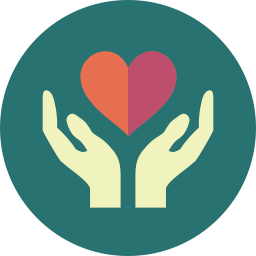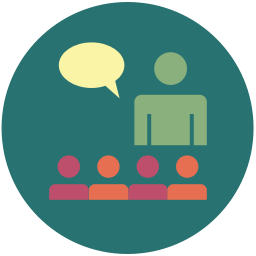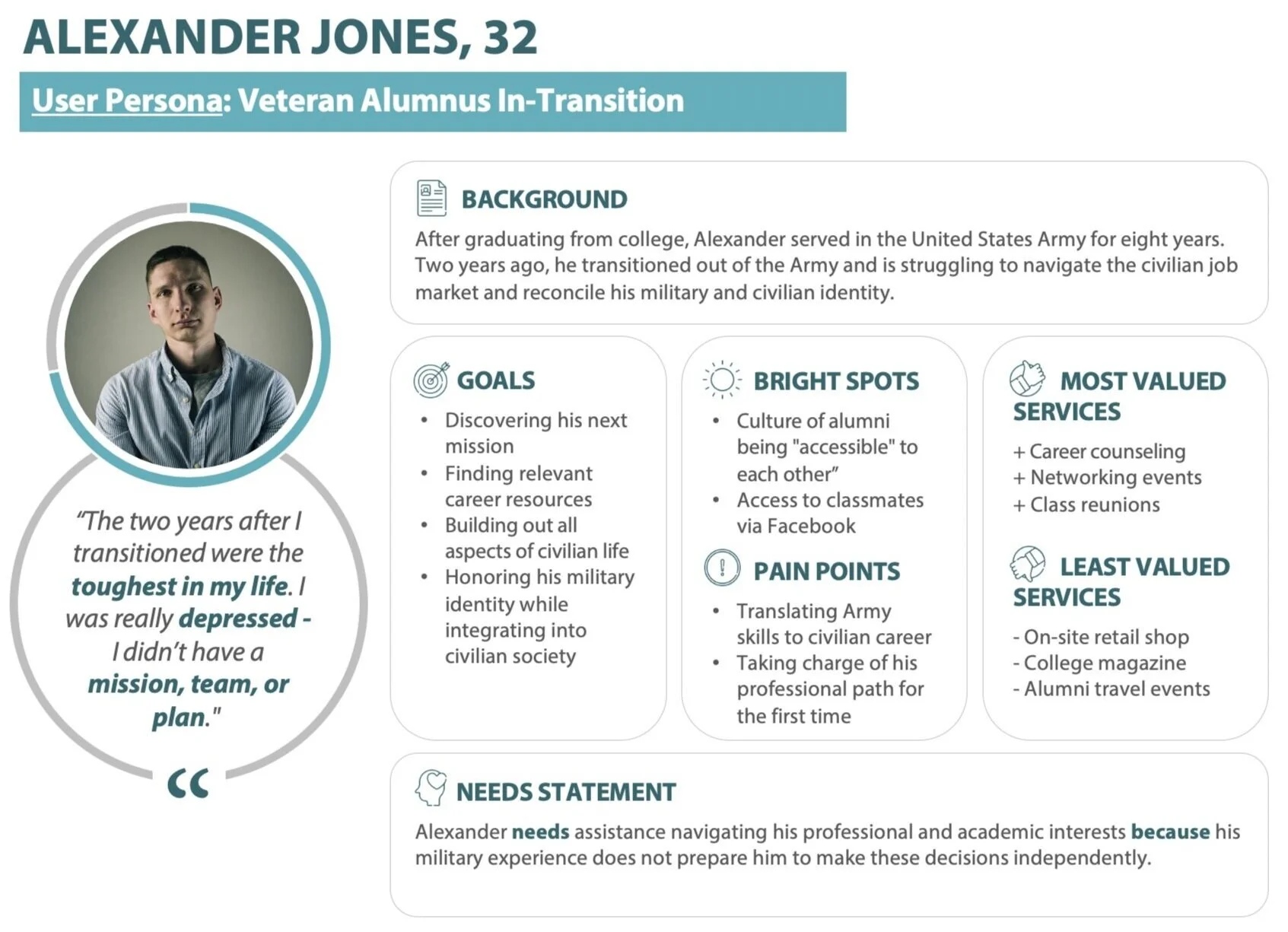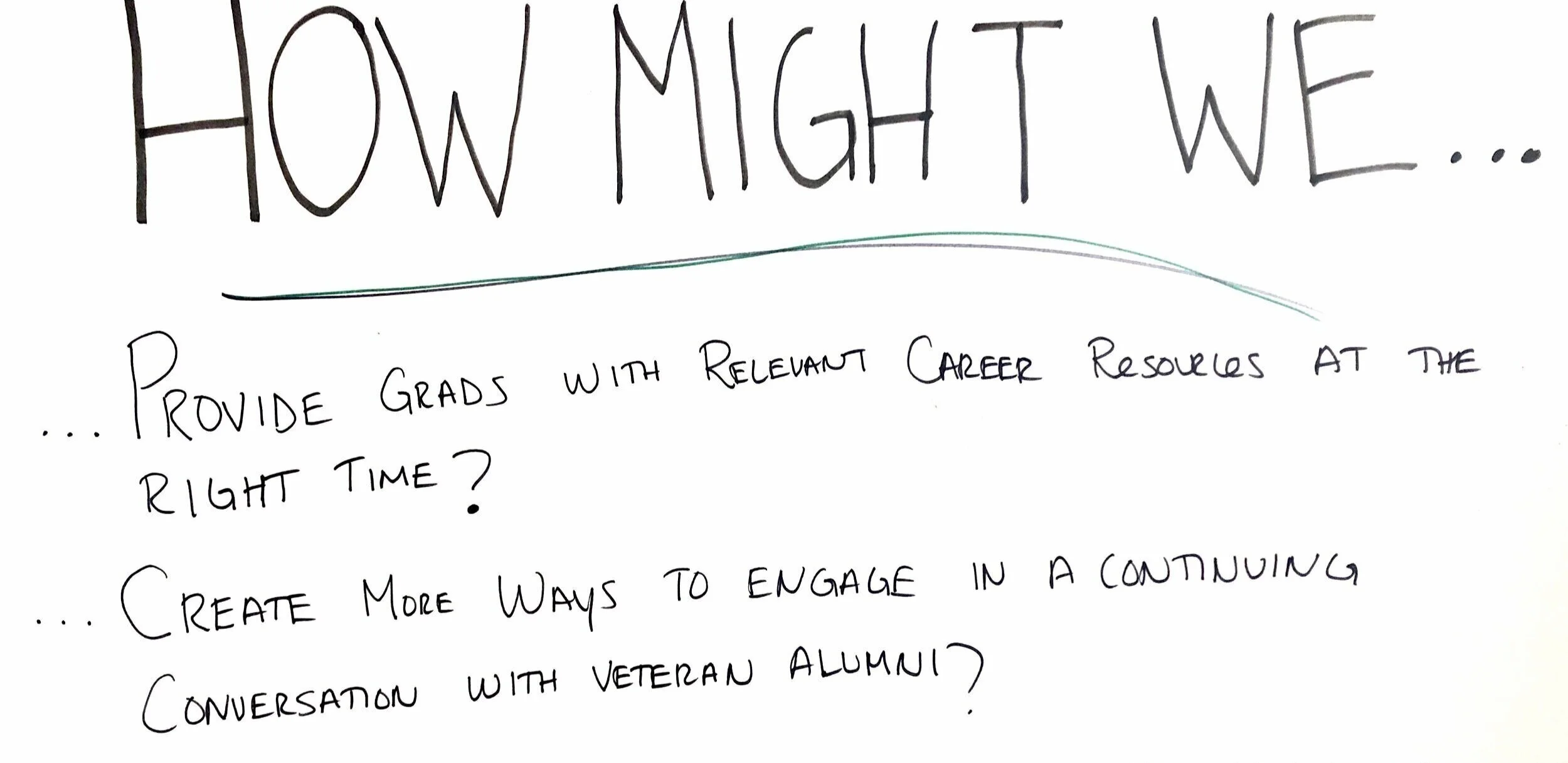To comply with my non-disclosure agreement, I have omitted and replaced confidential information in this case.
CHALLENGE
River Vista, a prestigious U.S.-based college with a robust population of active-duty and veteran service members, was struggling to engage their veteran alumni. They partnered with Rios Partners to create a comprehensive vision of alumni services they would develop to maximize engagement over the next 10 years.
RESULTS
We designed 18 interventions aimed at increasing alumni engagement, along with a 10-year implementation roadmap that outlined the testing, piloting, rolling out, and measurement phases of each solution. The partner included 16/18 of our proposed interventions in its 10-year strategic plan.
MY EXPERTISE
User research and synthesis, customer journey mapping, user persona development, service assessment & validation, rapid prototyping, usability testing, cost analysis, KPI development, service roadmap strategy.
5-6 WEEKS
01/ Discover
Collect and synthesize data focused on the user experience
KEY DELIVERABLES
70+ interviews conducted & synthesized
1 current state user journey map
9 user personas with needs statements
5 communication touchpoints analyzed
6 “Moments that Matter”
40 alumni services validated with users
KEY ACTIVITIES
Ethnographic research & synthesis
User journey mapping
Persona development
Touchpoint assessment
“Moments that Matter” identification
Service assessment & validation
Aligning design strategy with business goals
River Vista’s challenge was increasing engagement of its military veteran alumni, so we first worked with our partner to define “engagement”. We identified four key behaviors that showed alumni engagement and built an engagement score based on how often each alumni did each of those behaviors. This allowed us to quickly identify “mainstream” and “extreme” users for our design research to ensure we capture a broad set of perspectives that accurately reflect the veteran alumni population. We designed future services around increasing this engagement score.
All future services would focus on increasing 4 engagement behaviors among veteran alumni
Volunteering (time, money)
Communicating (email, social)
Participating (events, reunions)
Using Services (career, tours)
Conducting and synthesizing in-depth ethnographic research
We spent 100+ hours interviewing military students and veteran alumni at various life stages, conducting collaborative activities, and participating in services ourselves to gather insights on the alumni experience and identify opportunities for improvement. Over the course of our research, we uncovered graduate’s core pain points and needs. We found that they universally value opportunities to engage with cadets and classmates. They need relevant services that meet them where there are in terms of life stage, interests, time, and money. They also have high expectations of the alumni network and the association’s responsibility to open doors.
“I bet there are grads who want a business relationship with me. The association is uniquely positioned to facilitate these introductions.”
“The association seems stale — old people doing boring stuff. Something my 87-year-old godmother would do. ”
By synthesizing dozens of hours of qualitative research into easily digestible reports and visualizations, we were able to facilitate productive conversations with the partner and align on alumni’s most urgent needs.
Building empathy with users personas
Using qualitative and quantitative data from interviews and surveys, we defined 9 user personas to build empathy with veteran alumni and to better understand their unique goals, needs, and experiences. I took lead on developing and refining these personas and designed the template below. We used these personas consistently throughout the project to guide our design decisions, priorities, and to facilitate discussions with River Vista about our users’ needs.
Developing a shared understanding of the veteran alumni journey
I created River Vista’s first-ever user journey map, which we used as a “common operating picture” of the end-to-end alumni experience. The map served as a comprehensive assessment of user journey and the different stages at which veteran are engaged with and engaged by alumni services. To this day, River Vista College uses this strategic resource to drive human-centered decision making and to identify support opportunities for veteran alumni across their entire life journey.
Identifying “Moments that Matter”(MTM) — significant junctures in the veteran grad’s journey during which the partner can and should play a role
At this stage, we started to develop a deep understanding of what veteran graduates are thinking, doing, and feeling at every life stage and which inflection points are most important to them. We prioritized 6 moments that we felt had the most significant potential to impact the alumni experience and made sure that our design solutions were targeted at these important junctures.
02/ Design
Generate potential solutions, conduct rapid prototyping, iterate
4-5 WEEKS
KEY DELIVERABLES
400+ potential ideas
20 low-fidelity prototypes
25 user testing sessions
18 final interventions
1 ideal user journey map
KEY ACTIVITIES
Design principle development
Ideation / brainstorm workshops
Sticker voting prioritization
Rapid prototyping
User testing and iteration
Ideal journey mapping
Establishing design principles to sustain core values through ideation
We codified the key concepts heard during the Discover Phase into a set of design principles that served as the bedrock of our solutions. By embracing the following three principles, we were able to continue iterating on our solutions without losing the ethos of the project.
Transitioning from problem identification to solution exploration
By reframing alumni’s challenges into “How Might We” questions, we were able to attack different aspects of the issue, explore a wide solution space, and focus on solving the most pressing problems facing alumni.
Harnessing collective thinking to generate a wide solution space
I planned and facilitated 4 ideation workshops with diverse stakeholders. During these sessions, I leveraged an array of individual and group brainstorming techniques to ensure volume and variety in the ideas we produced. In total, we generated 400+ ideas that were tailored to user personas and targeted at moments that matter and user journey stages. We used sticker voting to prioritize our ideas into three categories: most feasible in the near future, most likely to delight, and game changer. Finally, we evaluated each prioritized intervention to ensure it met our criteria for alumni engagement, i.e., participating, leveraging services, communicating, and volunteering. This process resulted in 20 “high-impact” solutions for rapid prototyping.
Making ideas tangible with rapid prototyping
We developed 20 unique prototypes, including paper sketches, digital wireframes, and audio experiences. We tested each prototype with users and iterated on its design based on feedback received. I had to think creatively about developing tests for multiple modalities, as our prototypes ranged from service strategies to online experiences to physical products. Even though these prototypes were low-fidelity, it was immensely rewarding to hear participants tell us that they would definitely be more involved as alumni if these services were made available by River Vista College.
3-4 WEEKS
03/ Refine and Implement
Form an implementation and launch plan
KEY DELIVERABLES
10-year roadmap outlining the testing, iterating, and rolling out phases of 18 proposed solutions
KPIs targeted at measuring the user journey and ROI of the proposed solutions
Presentation summarizing final recommendations for the Board of Directors
KEY ACTIVITIES
Service roadmap development
Performance metrics (KPI) development
Resource mapping
Estimated potential impact on alumni engagement
Setting River Vista Alumni Association up for success with a detailed implementation plan and service roadmap
Our team identified and refined target design solutions and formed a launch plan for our partner. I led the development of a service roadmap and implementation plan, which outlined the full lifecycle of each solution (testing, piloting, and rolling out) recommended by our team over the next 10 years. I also help develop a suite of performance measures targeted at measuring both the customer journey as well as the ROI of the interventions we proposed over the next decade. Finally, we pulled together a recommendation, including investment required, that was presented to the board of directors.
Each of the 18 solutions proposed included the following information in the implementation
Key Resources
➞
People required (new/existing), processes, tools, who owns it
Investment Required
➞
People, tools, time - startup costs, run rate, first year costs
Potential Impact
➞
Grads impacted, engagement behaviors driven, MTM targeted
Performance Metrics
➞
How to measure engagement behaviors and alumni satisfaction
Implementation Plan
➞
Objectives, activities to execute, and outputs by stage
Project Impact
River Vista College incorporated nearly all of our proposed interventions (16/18) in its 10-year strategic plan. Furthermore, several active-duty service members and veterans who were involved in the Discover and Design Phase said they would donate a sizable amount of money to the association or otherwise get involved as a result of this project.











